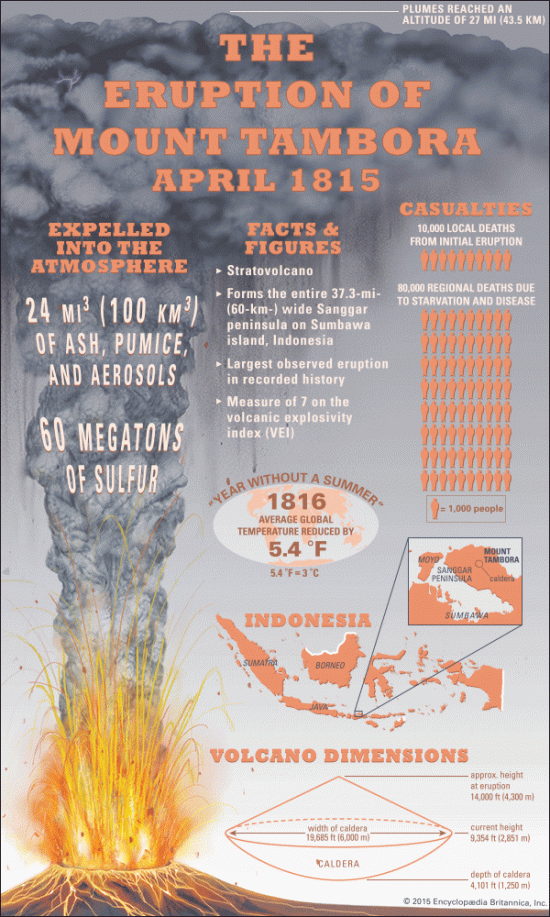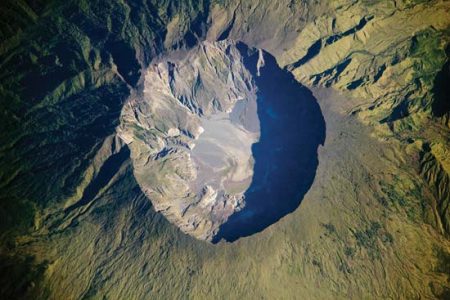March 14, 2017 – The largest volcanic eruption in recent history began on April 5, 1815, at Mount Tambora, Sumbawa Island, Indonesia. The final event of this volcanic eruption took place several days later on April 10 when the mountain blew apart with an ash cloud rising 40 kilometers (25 miles) into the air. The sonic boom could be heard 2,000 kilometers (1,200 miles) away. The eruption was 10 times more powerful than the better known Krakatau which occurred in 1883.
Almost 150 cubic kilometers (36 cubic miles) of ash and pumice as well 60 megatons of sulfur aerosols spewed into the atmosphere. On Sumbawa and its surroundings, 10,000 died immediately from pyroclastic flows that roared down the mountainside at speeds of 160 kilometers (100 miles) per hour. The flows ended at the Java Sea, some 40 kilometers (25 miles) away. The eruption spawned a tsunami that sent 2-meter (7 foot) waves rushing across the Java Sea to pile up on nearby shores.
A mountain that once stood 4,300 meters (14,000 feet) in height, as tall as Mount Rainier in Washington state, was decapitated leaving a crater, 1,250 meters (4,100 feet) deep in its wake, and 6 kilometers (3.7 miles) in diameter. Ash falls covered more than a million square kilometers (386,000 square miles). The ash spread more than a million square kilometers (386,000 square miles). Those living nearby, not immediately killed by the eruption, were soon to face other deprivations as the ash rained down for weeks. It was so much that the volume and weight caused homes to collapse, crops and forests to die and a death toll of more than 90,000, mostly from starvation and disease.

By mid-July, the eruption petered out but in its wake, Mount Tambora was to leave an enduring legacy as sulfuric acid and ash reached into the stratosphere spreading around the planet and creating a haze that blocked sunlight for several years.
A year later the Northern Hemisphere experienced an unseasonable chill with recollections of the year without summer captured in the personal correspondence and diaries of notables of the day. Pharaoh Chesney, a Virginian, described a June snowfall with folks going sledding. July 4th Independence Day celebrations had to be moved inside because snow fell and water froze. The ex-President, Thomas Jefferson, saw his corn crop die as he applied for a loan to cover his losses. New Englanders experienced clothing freezing solid when hung out on a line to dry, as well as failed crops. Many picked up and moved to the Ohio River valley and points further west to start over rather than face further failed harvests and uncertain weather. Vermont alone recorded 15,000 of its citizens leaving to seek warmer and greener pastures. In Europe, Ireland had continuous rain for 8 weeks causing the potato crop to fail. Famine followed along with typhus, killing thousands. Throughout Great Britain and Europe corn and wheat crops never matured in what one historian, John D. Post, described as “the last great subsistence crisis in the western world.”
Eye witnesses to the events of that year such as Lord Byron penned an ode to the times in a poem he entitled “Darkness.” Written in the summer of 1816 he uses word pictures like a “morn came and went–and came, and brought no day,” and “a fearful hope was all the world contain’d….despairing light wore an unearthly aspect.” Even the story of Frankenstein, first conceived in 1816 by Mary Shelley, may have been inspired by the gloom and foreboding of that summer. In her conception of the monster, she made a statement about humanity tampering with nature. Little did she know that in 1816, nature was the cause.
Tambora was not a one-time event on the planet but it certainly stands out in 19th-century history. Krakatau may be more well known only because its eruption occurred when telegraphy had been invented, spreading the news around the world. But the lessons we can learn from Tambora, and to a lesser extent Krakatau, show us that what gets put into the atmosphere can have profound short to long-term impacts on climate. Greenhouse gasses warm the atmosphere. Aerosols, such as those Tambora put into the stratosphere, cool it. Aerosols, unlike greenhouse gasses like carbon dioxide (CO2), can settle in a few years. But CO2 stays in the atmosphere for centuries. The effect of CO2 and other greenhouse gasses produced by human activity today is insidious because of accumulations over time. We haven’t switched off the CO2, methane (CH4). and nitrous oxides (NO2) pump since the Industrial Revolution began. Year after year the gasses accumulate.
When Tambora erupted it caused short-term climate change. One volcano and look at the consequences globally — famine, disease, and climate refugees. Today we talk about the warmest years on record, it seems every year. Temperatures in the Middle East, Australia, and North Africa now exceed 50 Celsius (122 Fahrenheit) degrees regularly during the peak summer period. Droughts have become more commonplace in the Horn and Southern Cape of Africa, parts of Southwestern United States, in Amazonia, the Indus River valley, central Asia, and western China. As warmer temperatures move to higher latitudes so too does biology adapted to the warmth. Migration patterns alter. Mosquito-borne diseases normally occurring only in the tropics find their way to temperate zones. The latest scare is Zika, following Dengue fever, Chikungunya, and Malaria.
That is why the recent World Economic Forum held in Davos, Switzerland, described climate change as the number one major risk to the planet, ahead of population growth, pollution and disruption to global trade. And that’s why the American Pentagon describes climate change as a threat to the United States and the globe.
The lessons of Mount Tambora need repeating in halls of government around the planet. We are today, more vulnerable as a species and civilization than at any time in the 20th century when we fought two world wars. The enemy this time isn’t unbridled nationalism, race theories and imperialistic dreams of world dominance. Instead, it is our own inaction in the face of overwhelming scientific evidence.









